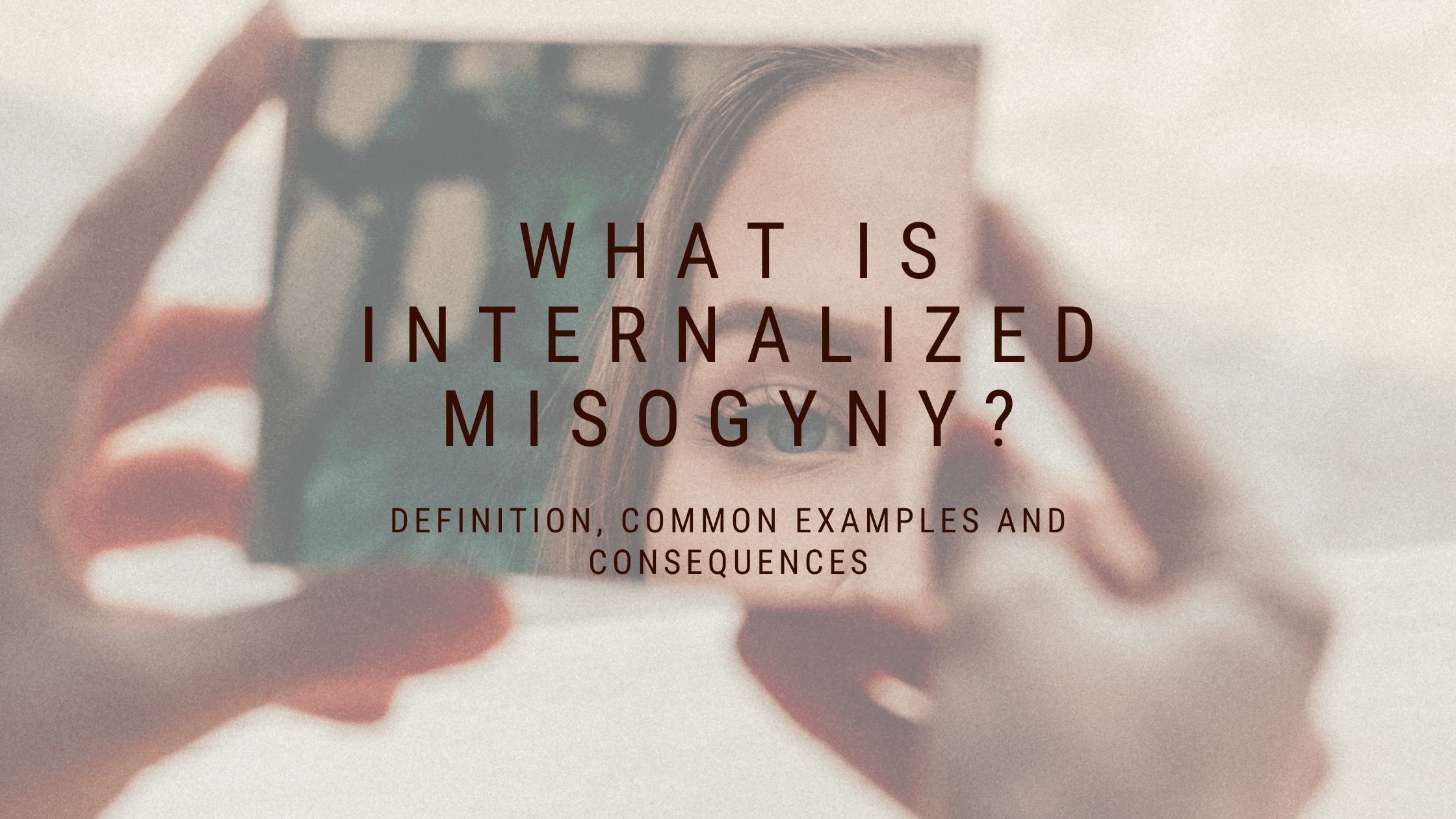What is Internalized Misogyny: Understanding and Combating Internal Prejudice

Internalized misogyny refers to prejudices and negative stereotypes against women that are internalized by women themselves.
Why is it important to discuss?
You cannot talk about combating gender violence without better understanding this phenomenon.
Internalized misogyny is the result of centuries of patriarchal norms and values that have permeated society and culture. Understanding internalized misogyny is crucial because it affects women’s self-perception, their relationships, and their role in society. Its presence can limit ambitions, erode self-esteem, and perpetuate gender inequalities. Discussing and addressing this issue is therefore essential for promoting gender equality and individual well-being.
What is the purpose of this article?
The goal of this article is to provide a deep understanding of internalized misogyny by exploring how it manifests in everyday life and its consequences. Additionally, strategies for recognizing and combating internalized misogyny will be presented. This article aims to raise awareness and provide practical tools to help women free themselves from internalized prejudices, promoting greater awareness and positive change at both personal and social levels.
Let us first try to give a more detailed definition to this phenomenon.

Defining Internalized Misogyny
Internalized misogyny is the incorporation of misogynistic attitudes and beliefs by women themselves.
This means that women can unconsciously accept and perpetuate the same sexist norms that oppress them.
Unlike external misogyny, which is openly expressed through actions and words by others, internalized misogyny is more subtle and rooted in self-directed thoughts and behaviors. Women may judge themselves and other women by unrealistic and harmful standards, contributing to the maintenance of a patriarchal culture.

Origins and Causes
Internalized misogyny has deep roots in history and culture. Patriarchal norms are transmitted through families, education, media, and religious institutions.
“Woman is an animal that is neither firm nor constant; it is malignant and aims to humiliate the husband, it is full of malice and the beginning of all quarrels and wars, the way and path of all iniquities.”
Saint Augustine
From childhood, girls are exposed to messages promoting the idea that women are inferior to men, should conform to specific roles, and that their value is tied to physical appearance or caregiving abilities. These messages are so pervasive that they become part of women’s identity, influencing how they see themselves and their place in the world.

Common Examples of Internalized Misogyny
Internalized misogyny manifests in many forms in daily life. For example,
- a woman may criticize herself for not being thin enough, beautiful enough, or competent enough, constantly comparing herself to unattainable standards promoted by the media.
- she may also judge other women for their personal choices, such as deciding whether to have children or pursue a career instead of dedicating themselves solely to family.
These harsh and often unconscious judgments perpetuate a cycle of negativity and competition among women, reinforcing the same oppressive structures that internalized misogyny represents.
But let’s see how internalized misogyny manifests itself both in everyday life, in professional life, in education, in personal relationships, and in justice.

Manifestations of Internalized Misogyny
Everyday Life
In everyday life, internalized misogyny manifests in self-sabotaging behaviors and attitudes. A woman may avoid expressing her opinions for fear of being judged or underestimated. She may also downplay her achievements, attributing them to luck rather than her abilities.
Additionally, women may internalize the idea that their value depends on their physical appearance, dedicating time and energy to conform to unrealistic beauty standards. These behaviors limit individual potential and contribute to the perpetuation of gender stereotypes.

Career and education
Internalized misogyny can significantly impact women’s professional and academic ambitions. Women may feel less inclined to apply for leadership roles or ask for salary increases, believing they are not qualified. This phenomenon is often described as the “glass ceiling,” an invisible barrier that prevents women from reaching positions of power.
Women may also limit their educational choices, avoiding fields perceived as “male” or too competitive. These attitudes contribute to gender disparity in the workplace and higher education.
Personal relationships
Internalized misogyny can lead to unbalanced power dynamics and submissive behaviors. A woman may accept abusive or demeaning behaviors from her partner, believing she deserves such treatment or cannot find better. She may also internalize the idea that her primary role is to support and please others, putting others’ needs before her own.
This internalization of roles and expectations can make women more vulnerable to both psychological and physical abuse.
When a woman has internalized the idea of being inferior or less deserving of respect, she may be less likely to recognize signs of abuse or seek help. The belief that one’s value is tied to maintaining a relationship, regardless of circumstances, can lead to tolerating dangerous situations and remaining in abusive relationships. Internalized misogyny can thus create a cycle of violence and submission from which it is difficult to escape without external support and a renewed awareness of one’s value and rights.
Barriers to Justice
Internalized misogyny can also severely hinder women from seeking justice for wrongs suffered or domestic violence. Women who have internalized misogynistic attitudes may feel guilty or responsible for the violence they have experienced, downplaying the incident or justifying the perpetrator’s behavior. This can lead to a reluctance to report abuse to authorities, fearing they will not be believed or judged negatively. Moreover, society can reinforce these fears, perpetuating the stigmatization of victims of violence and creating an environment where women feel isolated and powerless. This phenomenon not only prevents victims from obtaining justice but also reinforces the impunity of perpetrators, perpetuating a cycle of violence and oppression.
Internalized misogyny can also affect the decision-making power of women in positions of authority, such as judges, lawyers, or executives. These women, if influenced by internalized misogynistic attitudes, may unconsciously judge other women more harshly or skeptically. For example, a female judge might be less inclined to believe the testimony of a domestic violence victim or seriously consider her requests for protection if she has internalized biases that minimize the importance of gender-based violence. Similarly, women in decision-making positions may not adequately support policies or initiatives aimed at protecting and promoting women’s rights. This further reinforces the systemic and cultural barriers that prevent women from obtaining justice and perpetuates gender inequality.
“A woman must be a cute, cuddly, naive little thing – tender, sweet, and stupid.”
Adolf Hitler
Consequences of Internalized Misogyny

At an individual level
Internalized misogyny can have devastating effects on women’s mental health and well-being. Women who internalize misogynistic attitudes often struggle with low self-esteem, anxiety, and depression. They may have difficulty recognizing and valuing their own achievements, constantly feeling inadequate. This sense of inadequacy can lead to self-destructive behaviors and a reduced quality of life. Furthermore, women may socially isolate themselves, avoiding situations where they feel judged or inadequate, thereby limiting their opportunities for personal growth and development.
Not only that. As evidenced by a study conducted by the Japan Society of Obstetrics and Gynecology, internalized misogyny can also have negative effects on women’s physical well-being. In particular, it can increase the severity of premenstrual syndrome and dysmenorrhea in young women.
At a societal level
Internalized misogyny contributes to perpetuating gender inequalities. When women internalize and reproduce gender stereotypes, they reinforce existing patriarchal structures. This can hinder progress toward gender equality, as women not only experience discrimination but also become inadvertent agents of it.
Internalized misogyny undermines solidarity among women, fostering competition rather than collaboration.
It also affects women’s participation in public and political life, limiting the diversity of voices and perspectives needed for a fair society.

Combating Internalized Misogyny

Recognizing the problem
The first step in combating internalized misogyny is recognizing the problem. This requires a process of self-reflection and awareness. Women must learn to identify self-sabotaging thoughts and behaviors and analyze the origins of these attitudes.
Tools such as personal journaling, meditation, and psychological counseling can be helpful. It is also important to educate oneself on topics of feminism and gender inequalities to better understand how internalized misogyny develops and perpetuates.
At a personal level
There are several strategies for combating internalized misogyny at a personal level.
Promoting self-compassion and self-acceptance is crucial.
Women can practice positive affirmation exercises, focus on their strengths, and celebrate both big and small successes.
Building support networks with other women can be extremely beneficial. These networks can offer emotional support, encouragement, and a sense of community. Participating in discussion groups, workshops, and women’s empowerment activities can help strengthen self-esteem and self-confidence.
At a community and societal level
Promoting education and awareness is essential. Awareness campaigns can help destigmatize discussions about internalized misogyny and spread positive messages.
In schools, gender education can help young people recognize and challenge gender stereotypes from an early age.
Media play a crucial role in representing positive and inclusive role models. Promoting diversity and inclusion in media can help change cultural norms and reduce the perpetuation of internalized misogyny.
Conclusion
In conclusion, internalized misogyny is a complex phenomenon resulting from centuries of patriarchal norms and values. It manifests in everyday life, careers, education, personal relationships, and justice, negatively affecting women’s mental health and well-being. At a societal level, it contributes to perpetuating gender inequalities and hinders progress toward greater equality. Recognizing internalized misogyny is the first step toward change, followed by personal and community interventions to combat it.
It is crucial for women and society as a whole to actively engage in recognizing and combating internalized misogyny. Each individual can make a difference through self-reflection, continuous education, and mutual support.
I encourage all women to challenge self-sabotaging thoughts and support other women in this process. Only through awareness and action can we create a more equitable and inclusive society.
Future Perspectives
Looking to the future, I sincerely hope to see growing awareness and ongoing commitment to combating internalized misogyny. But it won’t be easy. This requires joint efforts from individuals, communities, educational institutions, and media.
Only through a profound cultural change can we hope to overcome internalized misogyny and realize a world where women are free to express their full potential without being hindered by internal or external prejudices.
Thanks for reading this post to the end. Help me spread awareness by sharing this with your friends and leaving me a comment below. Thanks again!

References and resources
Books and articles
1. “The feminine mystique” by Betty Friedan – A feminist classic that explores how social norms impact women’s self-perception.
2. “Women Who Run With the Wolves: Myths and Stories of the Wild Woman Archetype” by Clarissa Pinkola Estes – A book that promotes self-acceptance and the rediscovery of female inner strength.
3. “Is there a relationship between internalized misogyny and premenstrual syndrome and dysmenorrhea in young women? A descriptive-relational study”, Rabiye Erenoğlu, Şengül Yaman Sözbir, Ayten Şentürk Erenel – Research on the effects of internalized misogyny on premenstrual syndrome.
Organizations and initiatives
1. Lean In – An organization founded by Sheryl Sandberg that supports women in leadership and self-esteem.
2. Girls Who Code – An initiative that promotes the inclusion of girls in the field of technology and programming.
3. #EndGenderStereotypes – Awareness campaign promoted by the European Union, which aims to raise awareness of the role of gender stereotypes in society.
